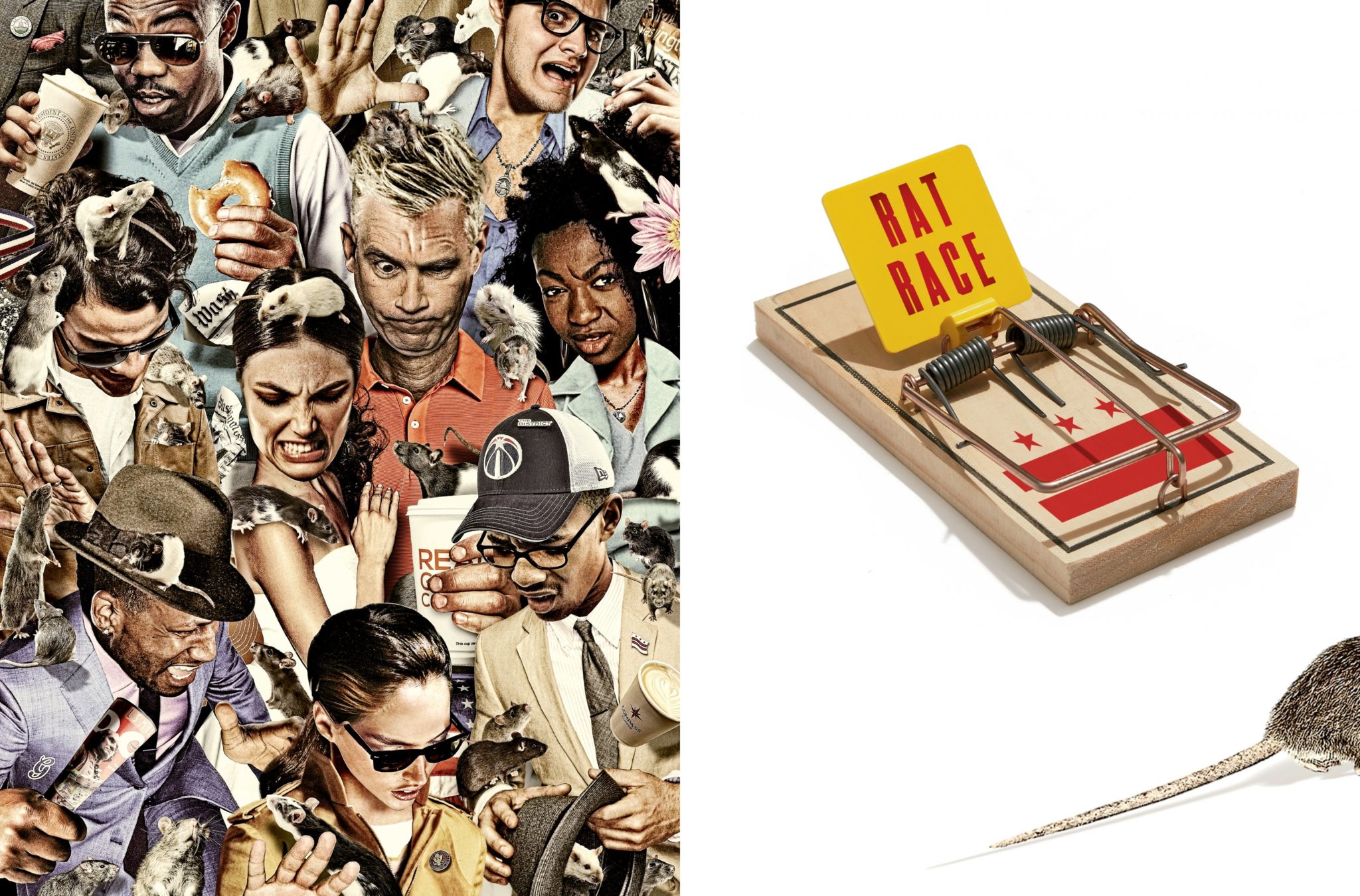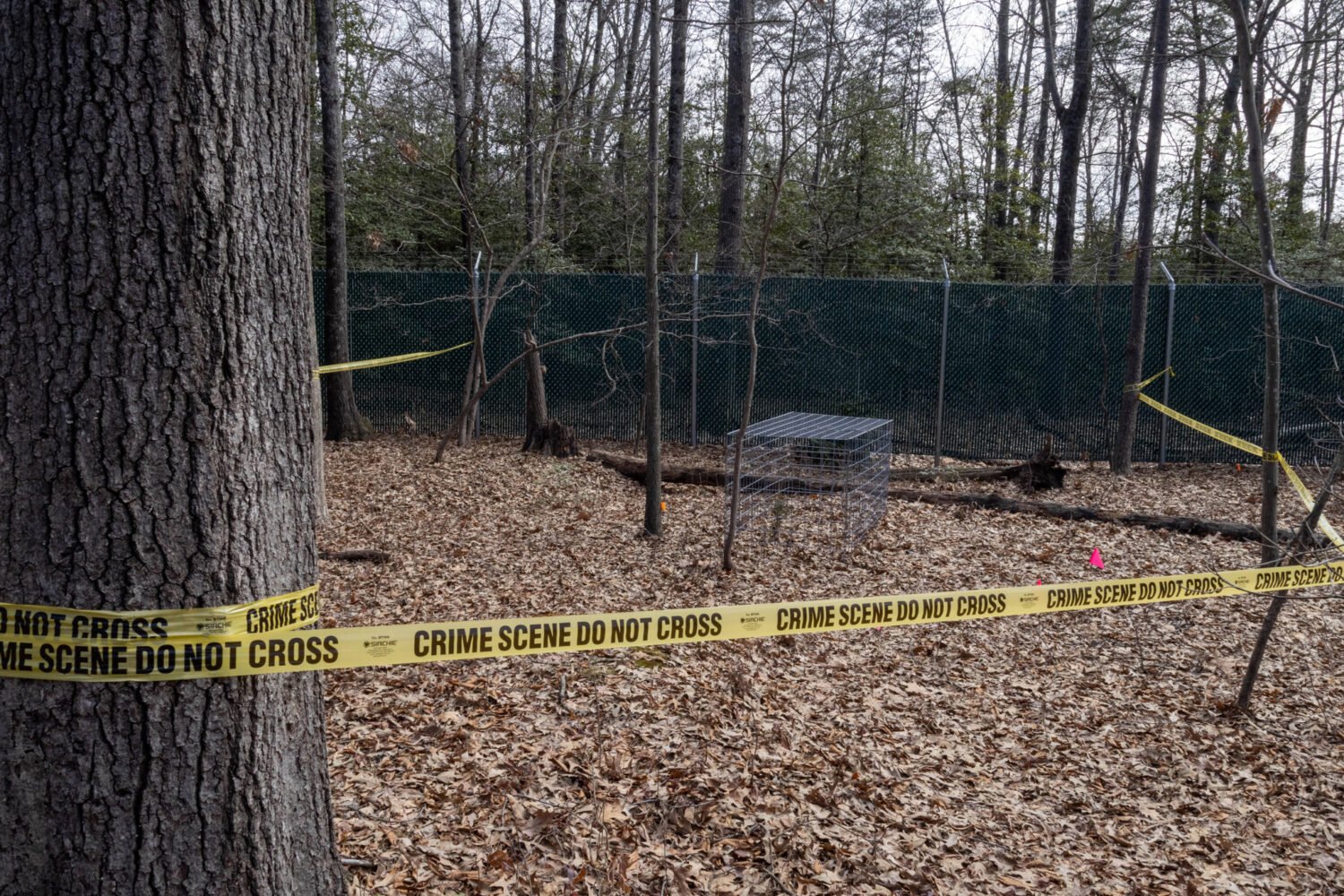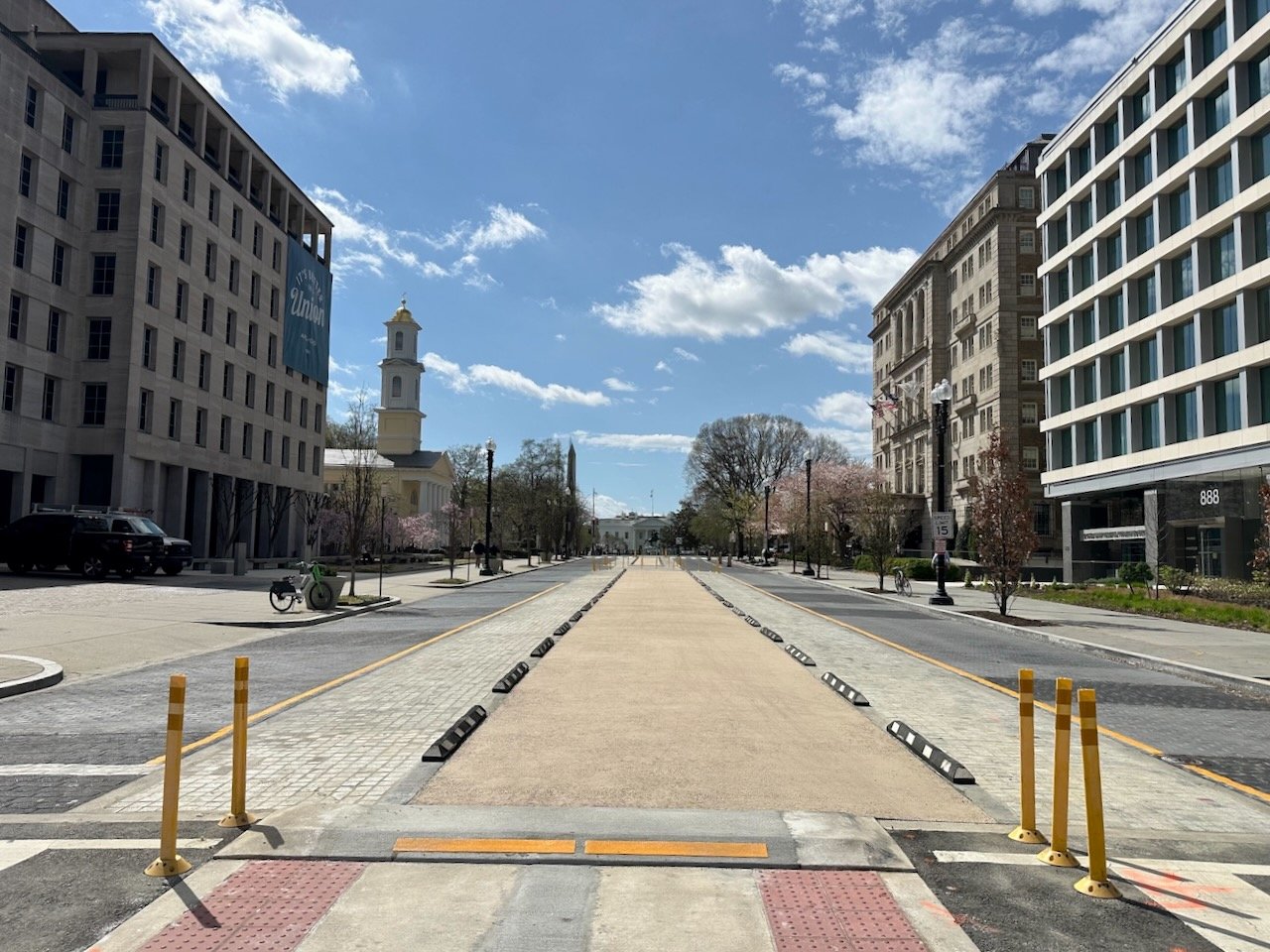“Hold this. How much do you think it weighs?”
Will Crane hands me a plastic garbage bag, the kind you buy at grocery stores, careful to have me grasp it by the top. The bottom hangs low and limp. I think I know what’s inside. I don’t think I want to look, and I definitely don’t want to smell. I’m not even sure I want to tell you about it—at least not if you’re reading this over lunch.
“Nine,” Crane says. “There’s nine in the bag. And that’s all from last night.”
Crane is talking about rats. Dead ones, to be precise. For weeks, I’ve been immersing myself in Washington’s War on Rats—not the metaphorical ones scurrying around Capitol Hill, har har, but the real, four-legged deal. Rattus norvegicus.The Norway rat. Better known as the street rat, the sewer rat, the wharf rat, the city rat. The brown, furry insurgents that gobble our trash, burrow under our parks and yards, scurry through the shadows of our streets and nightmares like bewhiskered little movie monsters and generally provoke a yuck-at-first-sight desire to burn down your entire house upon seeing one of them anywhere in its vicinity.
Along the way, I’ve seen rats chew through garbage cans and scale the sides of brick buildings, learned about reproductive proclivities that make rabbits look like monks, and listened in horror-slash-laughter to dozens of no-freaking-way rat stories, the terrible tales that too many Washingtonians have, including one from a woman who trapped a rat in her mother’s house near Eastern Market, hit it in the head with a hammer, watched it fall into an open pipe, poured boiling water down the pipe, and then finally had to “extract it, which was definitely traumatizing.”
In other words, I’ve seen and heard some stuff. Yet Crane’s bag leaves me speechless. It’s a warm night in Foggy Bottom, a little before 9, and neighborhood-association president Marina Streznewski has been leading me on a rat walk. She’s shown me where her dog caught and killed a rat. She’s shown me where she saw a group of rats eating inside a trash bag “make it look like the bag was dancing.” She’s bemoaned the student-rented group house she labels “ground zero for the whole block,” which sports three rat burrows in its front yard, right below an outdoor table coated with beer drippings and dotted by empty red party cups. As if to underscore the way rats can drive otherwise amicable blocks to civil war, she introduces me to a neighbor who curses yet another neighbor who allegedly “feeds the f—ing squirrels! Which feeds the f—ing rats!”
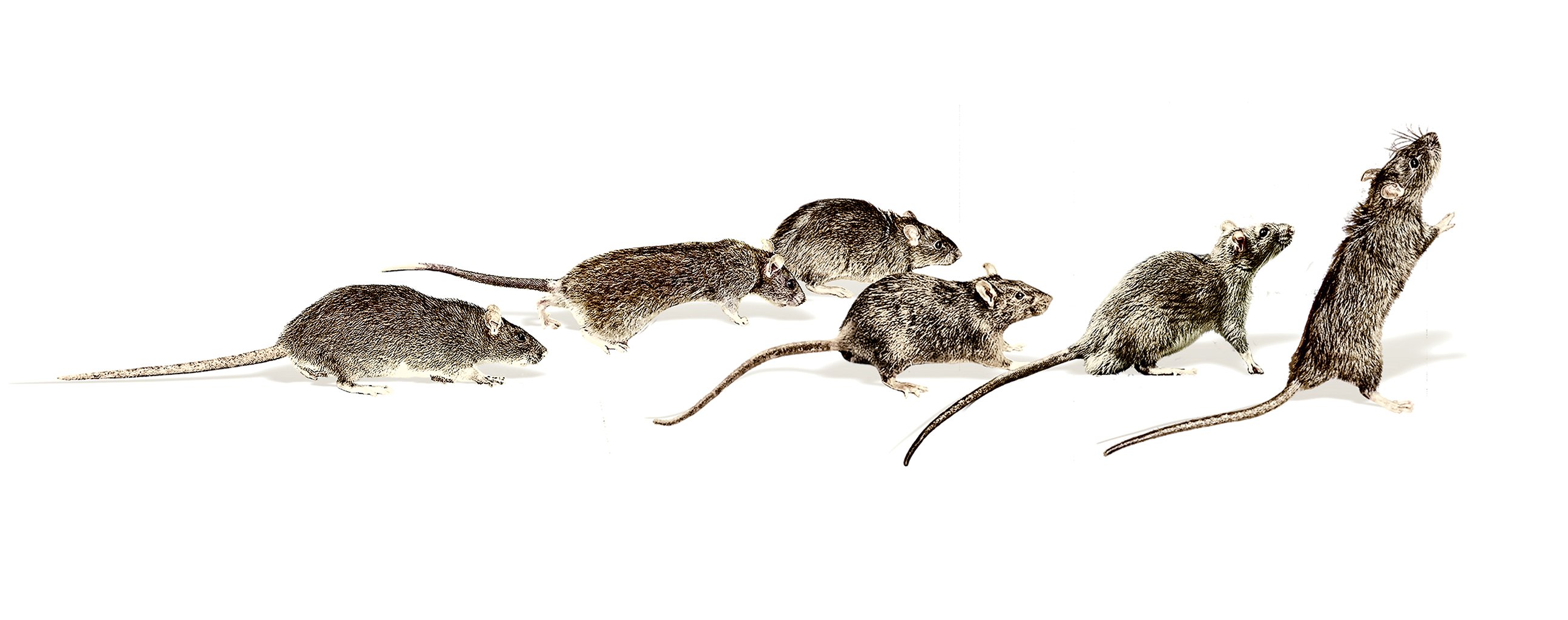
Then she introduces me to Crane, the neighborhood’s chief rat foe. A 40-year-old human-resources worker who has lived in the District since 1996, he’s a late convert to the cause. When he was a kid, his pets weren’t dogs or cats but, yes, rats. “They are actually very cool animals,” he says. “But they are also associated with Black Death.” (Recent research suggests that fleas and lice, not rats, spread medieval plague, but that’s another story.) Now, as an adult whose pricey home is in a rat-saturated part of a rat-saturated city, Crane has made up for lost time. To keep the cool but filthy animals out of his house and yard, he rebuilt his floors and walls and reinforced his wooden fence with nine-inch-high corrugated-steel panels. When that wasn’t enough, he started laying out a nightly perimeter of back-yard snap traps, baited with almonds and cashews. When that wasn’t enough, he began drilling tiny holes into the nuts, the better to secure them to the metal pedals that spring the traps. “Otherwise, the rats will just take them off without getting hit,” he says.
Standing by the gate to his back yard, we can hear Rattus norvegicus dashing around in the nearby darkness. Crane lets out an exasperated sigh. He tells me that rats chewed a hole in his fence, right above the steel; that he can hear them squeaking outside his bedroom window, night after night; that he feels he’s being overrun.
That’s when he breaks out the bag. “I trapped these rats [in the bag] over four hours,” he says. “Is that normal?” As he talks, Crane flashes a thousand-yard stare—the empty, unfocused gaze of battle fatigue, the lifeless eyes that say war is hell.
Probably, he’s just looking over my shoulder for rats.

Washington’s man-versus-rodent clash is practically as old as the city itself. Occasionally, it has escalated to shock-and-awe levels—most notably when the federal government helped fund a “war on rats” in the late 1960s and early ’70s and flooded the District with more than 100 pest-control workers.
More often, though, the skirmish has taken the form of a low-level siege. Consider our most famous residence. In the late 19th century, First Lady Caroline Harrison hired “a man with ferrets” to de-rat the White House. More than a half century later, and despite the benefits of modern, non-ferret-based sanitation, the war remained unwon; during the Ford administration, a large rat chased the National Security Council out of the Situation Room. At times, the vermin have turned otherwise mild-mannered statesmen into savage killers: In the early 1990s, a rat reportedly bit Barbara Bush’s English springer spaniel, Millie. On another occasion, the First Lady was swimming in the outdoor pool at 1600 Pennsylvania when a rat jumped in and was intercepted by President George H.W. Bush, who, she later recalled, “drowned the beast” with a pool-cleaning scoop.
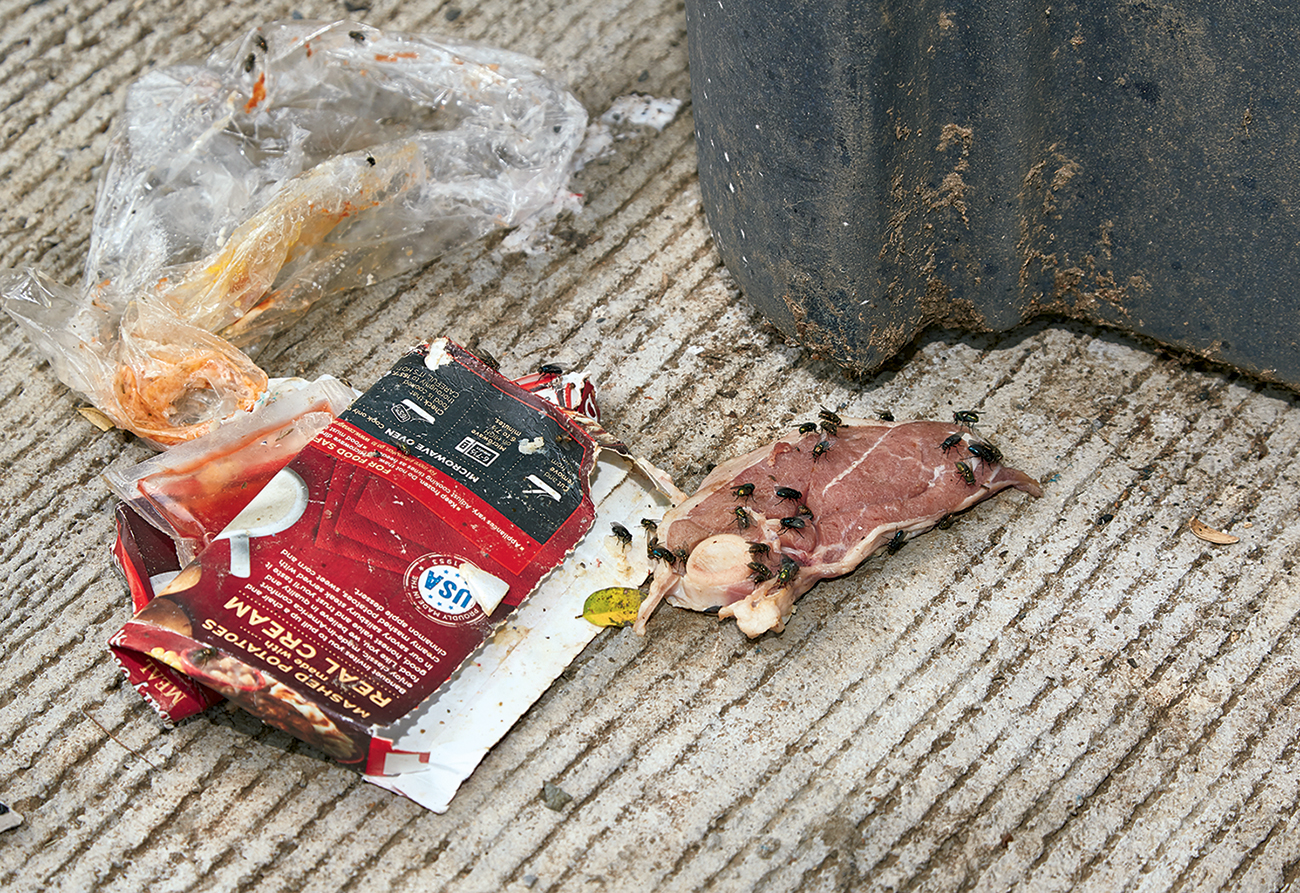
Washington is apparently still in search of that kind of gumption. In 2012, a suspected rat scampered in front of President Obama’s podium during a Rose Garden address. Last year, the pest-control company Orkin ranked Washington as the nation’s fifth-rattiest city—behind rodent standard-bearers New York and Chicago but ahead of longtime stalwarts Boston and Philadelphia—while 5,020 rat-complaint calls were made to the District’s 311 phone line, more than double the number in 2014.
I hadn’t ever called 311 myself, mostly because until I started reporting this story, I didn’t know that the line handled complaints. Talk about a missed opportunity. Earlier this year, two rats ran directly under my dog, an avid and committed squirrel chaser, right outside my Tenleytown condo building. One neighbor later told me rats had chewed through the electrical wiring in his van (fun fact: the Earth-friendly, soy-based wire coverings in many modern cars are believed to be tasty to rodents), while another confessed that when he took his car in for a tune-up, mechanics found chicken bones and rat droppings in the engine block.
But if there was a war on, I wanted to get to the front.

So I signed up for the District’s Rat Riddance & Rodent Vector Control Academy, an annual two-day boot camp for health and sanitation workers, private exterminators, concerned citizens, and anyone else interested in the finer points of, well, raticide. Held at One Judiciary Square and organized by Gerard Brown, the District’s longtime rodent-control manager, it’s the kind of event where you learn that rats can produce as many as 25,000 droppings and shed up to 1 million individual hairs in a single year. Also, it’s a good place to overhear conversations between federal building managers and city health inspectors that end with statements like Trust me, ‘humane’ might sound good, but not if you have a decomposing rat stuck in the wall of your cafeteria.
The star attraction is a man named Bobby Corrigan. A 67-year-old from New York City, he has a PhD in urban rodentology, which is a real thing, and a spot in the Pest Management Professional Hall of Fame, also a real thing.
“What is the biggest rat in DC you’ve ever seen?” Corrigan scans the room, looking for hands. “Anyone?”
“Two pounds,” says someone.
“One-point-six pounds,” says someone else.
“Ten pounds!” says a third person.
Everyone laughs. Corrigan shakes his head.
“If there are ten-pound rats in this city,” he says, “I am leaving on the next train.”
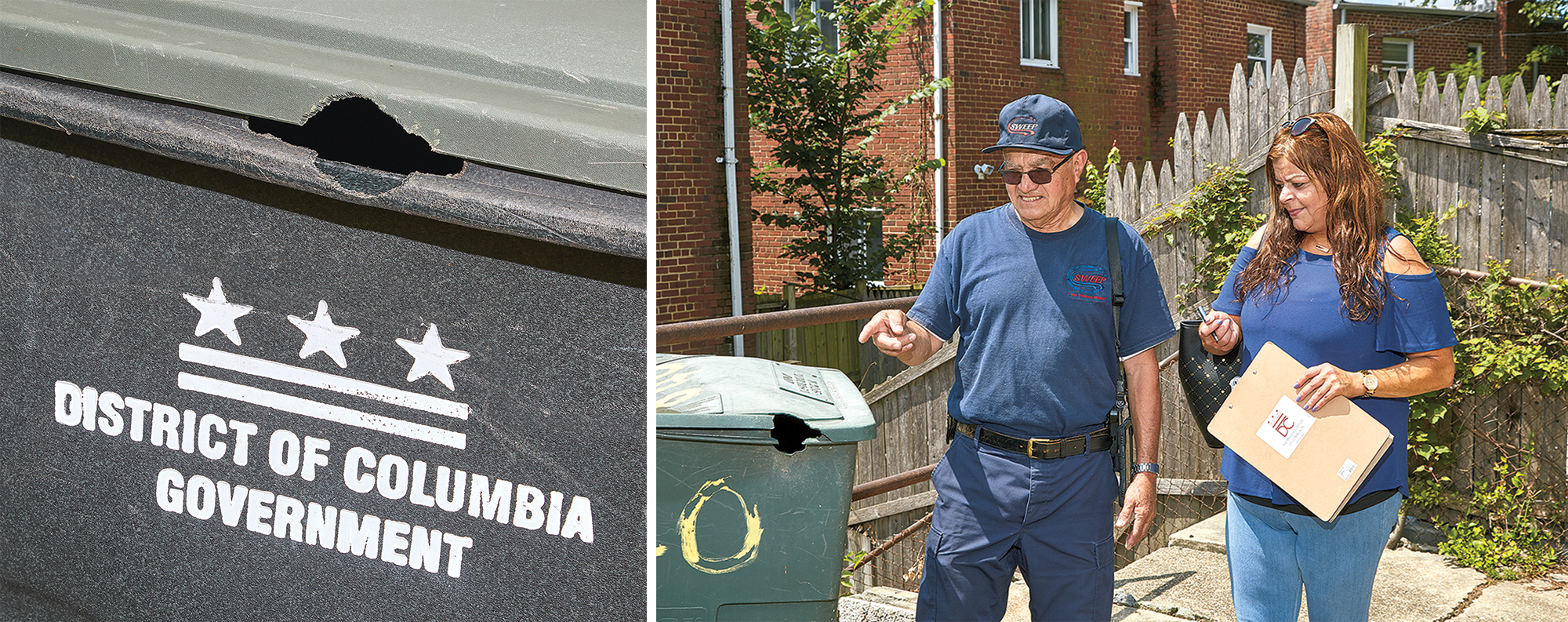
Becoming what Brown calls the Michael Jordan of rodent control wasn’t Corrigan’s original plan. “I wanted to be Jacques Cousteau,” he says. That changed one day at community college when an urban entomologist subbed for Corrigan’s oceanography instructor. “We started talking about cockroaches, ants, mice, and rats,” he says. “I went straight to the registrar after class and asked if I could get a degree in that.”
Corrigan has helped public-health officials in Brazil, Japan, and 46 states, and he once spent a night lying in a barn surrounded by peanut butter, the better to take photographs of rats. He loves dispelling myths, such as the notion of a ten-pounder. “The heaviest rat ever weighed was one pound, eight ounces,” he says. “People say, ‘The rats of my ward are as big as an alley cat!’ No, you saw an alley cat. If anyone in here comes up with a two-pound rat, I’m writing you a check for $300.”
Corrigan’s war stories include one from the Pentagon, where pest controllers found a snap trap containing a severed rat leg. “They asked me, ‘What’s your professional opinion? Is it dead?’ ” Corrigan says. “I said yes. A couple months later, I came back to teach a class. ‘Bobby,’ they told me, ‘you’re not going to believe it. We trapped a rat with three legs. We called him Stumpy.’ ”
I was hoping Corrigan would have good news—some reassurance that while things might look bad, Stumpy’s side was not, in fact, winning. No such luck. “The Norway rat is on the rise globally,” he says. “Every city I’ve been to in the past five years is seeing more rats.”
To illustrate, Corrigan gives us a field assignment: Break into small teams and survey five areas around the building, looking for signs of rats. My team includes Daryl, a private exterminator who used to work in Army intelligence and now supervises anti-rat efforts at the Wharf in Southwest DC, and Mike, a city pest controller who swears he once saw a gang of rats “jump a dog.” While Corrigan calls this a “blitz,” I figure the exercise will be uneventful—I’ve lived in Washington since the mid-1990s, walked in and out of the Judiciary Square Metro station at least a hundred times, and have never seen a rat in the area.
I am so, so wrong.
“Oh, god. That’s bigger than a cat.”
Under a tree across the street, we find three burrow holes in a dirt patch about as big as a large desk. At the entrance to a parking garage, we count 11 more holes, then trace rat “runways”—strips of bent grass indicating regular, nightly movement—from the holes to nearby garbage cans and hot-dog vendor carts.
Over the next hour, we spot burrows on every side of the building. Burrows under the foundation of an adjacent homeless shelter. Burrows just inside a nearby construction site. My notebook is filling up. Outside a ground-floor bakery, we find a black bait box—only it doesn’t contain rat poison. Instead, it’s stuffed with shredded cloth and aluminum foil, as well as a candy-bar wrapper. “The rats are living in this one,” Daryl says. “The foil is for insulation.”
At one point, Daryl drops to the ground to reach under a parked car. He emerges with a dead rat. It’s big—maybe big enough to capture Corrigan’s bounty.
“Oh, God,” says a passerby in a blue suit. “That’s bigger than a cat.”
Back in class, Corrigan breaks the bad news—our rat is “gassed up,” bloated from the biochemical vapors released during postmortem decomposition. His $300 remains safe.
Team by team, we present our findings. It turns out that one large planter box adjacent to Judiciary Square’s Metro escalators has 29 to 33 rat holes. Then it’s time for some quick math. Rat burrows generally have three holes—a front door for getting in and out, two back doors for emergencies. So 30 holes means ten burrows. According to Corrigan, the average burrow houses ten rats: a mom, a dad, and eight kids. Multiply ten by ten, and that’s 100 rats, all nesting in one box outside one building next to one Metro station. “The rats in this area,” Corrigan says, “are really doing well.”
Looking forward to your next jury-duty summons?

Gregory Cornes tells me to stand back. Clad in dark-blue pants and a matching long-sleeved shirt, he’s holding a device that looks like a stripped-down Super Soaker and is full of rat poison. But Cornes isn’t warning me about accidentally inhaling it.
“Every once in a while,” he says, “you hit a burrow and rats shoot out.”
We’re standing in an alley in Northeast DC, near the corner of Oglethorpe and Eighth streets. Cornes is here to treat the area—“treat” being a nice way of saying search and destroy. One of eight city exterminators, Cornes has worked in local government since 1985 and spent much of the last 15 years out of the office driving around town in a pickup truck to hunt rats. “I like this job better,” he says with a grin. “Dealing with rats, they don’t talk back.”
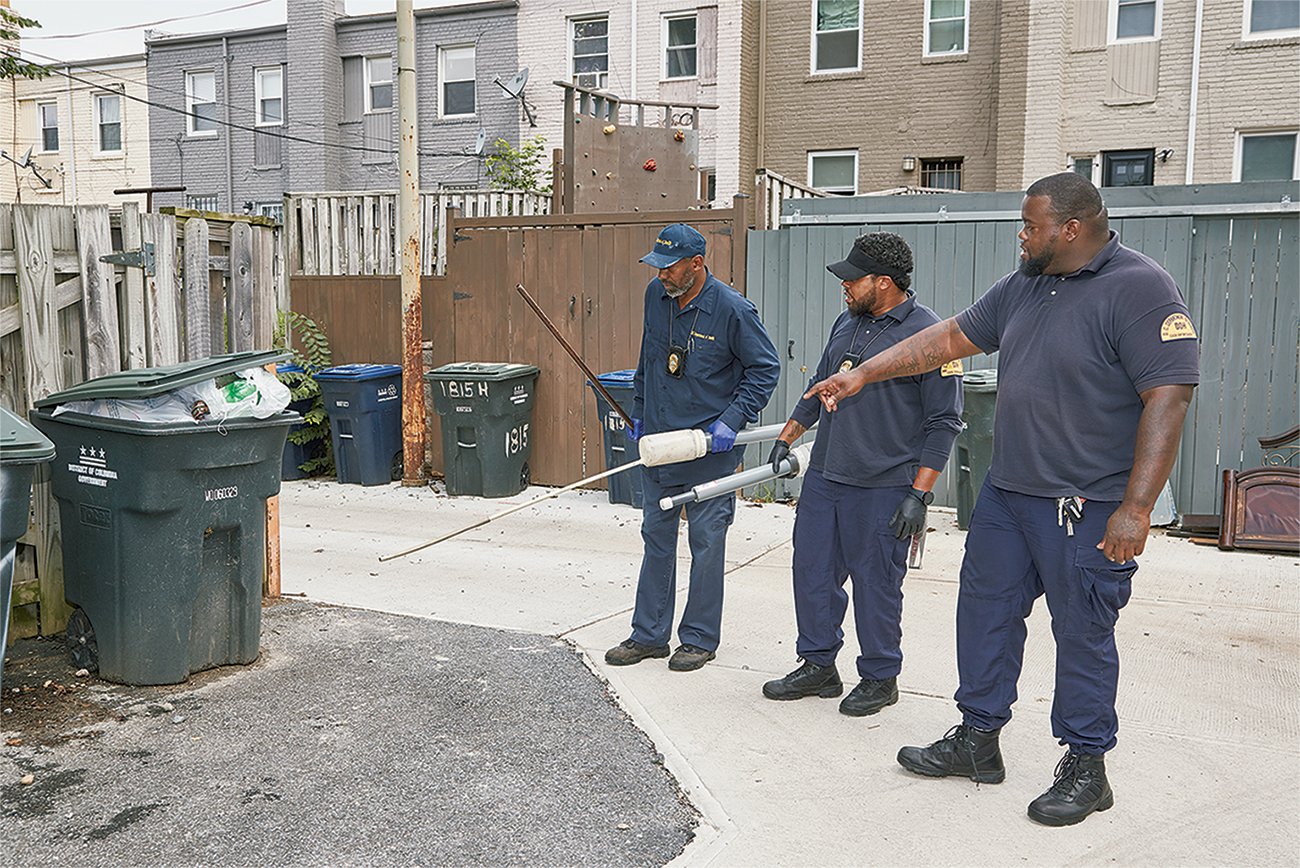
Cornes often ends up targeting alleys—in part because rats love garbage and in part because they try to avoid the humans who create it. He’ll pump one to three ounces of the poison into burrows. The powder sticks to their paws and fur; when they groom themselves, they unwittingly ingest it. Three to seven days later, the rats die. If this seems like a particularly fiendish way to go—a death wish ordered up by a Bond villain, or Vladimir Putin—well, they kind of deserve it.
The property destruction alone. . . . Experts believe that around one-quarter of all fires of unknown origin are caused by rats chewing through wires. In 1967, a single rat at a Washington-area power station caused a third of the District to lose power for 45 minutes.
Then there’s (shudder) the health issues. A 2014 Columbia University study found that rats “are reservoirs for a vast diversity of microbes that may affect human health,” including leptospirosis, a rare bacterial infection that last year killed one New York City resident and left two others hospitalized.
Poison is actually one of the more prosaic approaches to mankind’s war on rats. Examples of ingenuity used elsewhere include traps such as the “T-Rex,” which works like a guillotine and resembles a dinosaur’s mouth. Over the years, we’ve resorted to electrocution. We’ve conscripted ferrets, dogs, and cats as allies in our struggle. A few years ago, Chicago officials released 60 coyotes wearing radio collars onto the city’s streets. Sometimes, even our good old-fashioned poison efforts are indistinguishable from actual warfare: New Zealand recently cleared surrounding islands of rats by dropping poison from helicopters.
Washington’s current extermination efforts are somewhat less extreme. The District has experimented with stuffing dry ice into rat burrows in order to asphyxiate the inhabitants. Sometime soon, Brown tells me, his exterminators will experiment with a sticky-sweet ingestible liquid called ContraPest that renders rats infertile. The first field trial of the drug, conducted in the New York City subway, reduced the resident rat population by one-half over three months.
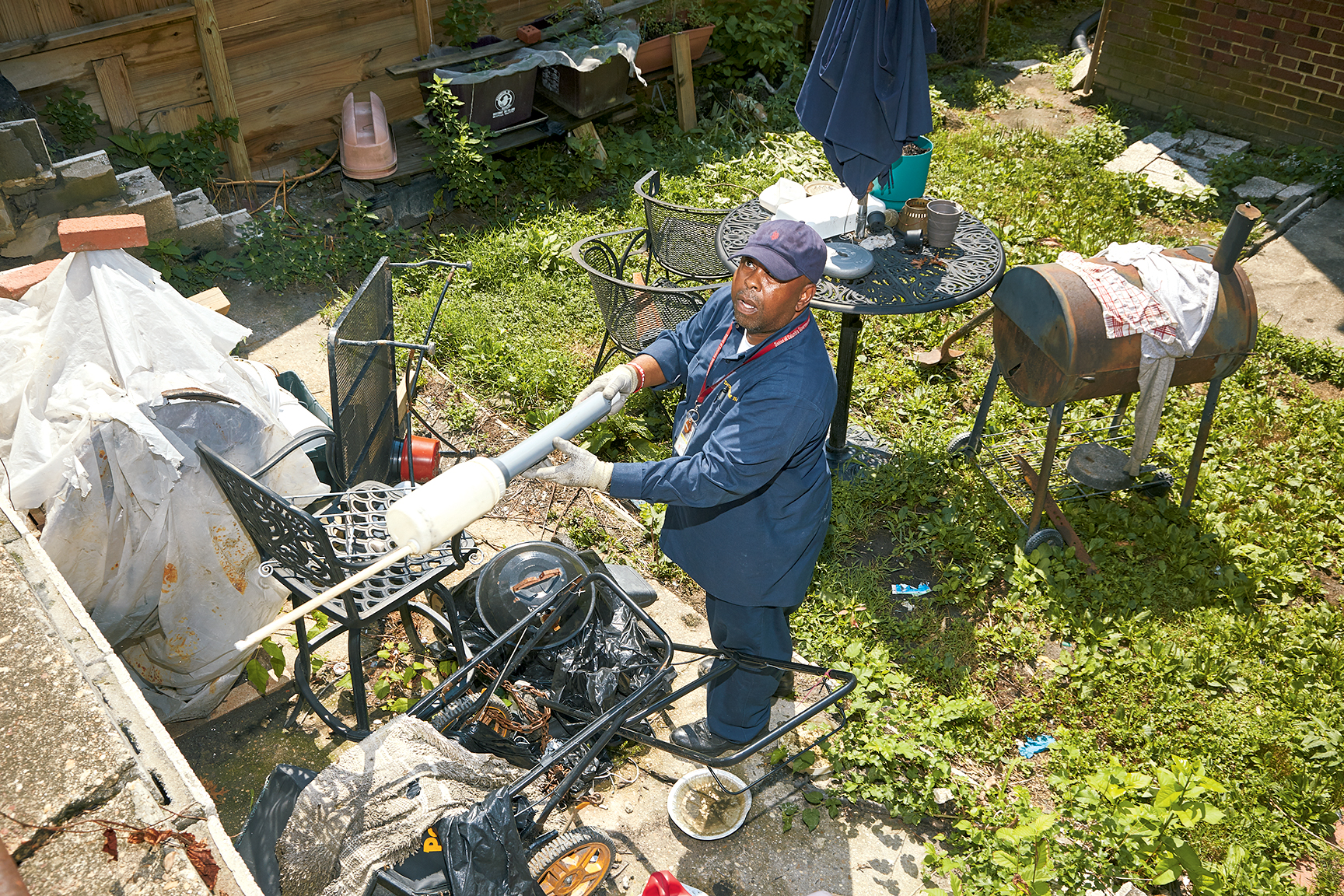
But like humans, rats have a way of keeping on. At the Rodent Academy, Corrigan plays a video. Four snap traps are arrayed in a row. A rat appears in the frame, whiskers twitching, curious and hungry.
Snap! A trap fires, striking the victim square in the head.
“Wait for it,” Corrigan says. “Wait for it—”
Nothing. The rat is still. Has to be dead. Only suddenly, it wiggles backward from the trap and runs away.
“Oh, Lordy Jesus!” someone says with a gasp.
Contrary to urban legend, rats cannot flatten their bodies like pancakes to slip beneath doors. But they can fit through holes and cracks bigger than 12 millimeters, the amount of space from the tops of their skulls to the bottoms of their jaws. Their bites are mini weapons of mass destruction. Armed with powerful facial muscles that can generate 6,000 pounds of force per square inch and teeth that are comparable in hardness to iron, they can chew through wood, plastic, and metal (as in fences, trash cans, and certain sewer pipes).
Because rats face perpetual danger, they’ve evolved to be both smart and paranoid—“diabolically clever,” according to a 1912 history of British mammals. They make up for limited vision through superior smell and touch, following familiar, safe paths marked by an oily, pheromone-laden substance that sloughs off their fur and sticks to objects that they brush against. While some rats have been measured roaming as far as five miles in a single night, most are homebodies that prefer to remain within a few hundred feet of their nests—i.e., the cozy living room they’ve constructed next to your rain barrel.
Rats may have sex 20 times a day, and a dominant male can hook up with 20 females over six hours.
One other exceptional behavioral quirk helps rats survive and thrive. “A lot of copulations occur among rodents,” as Corrigan likes to say. He’s being polite. According to the 2004 bestseller Rats by Robert Sullivan, male and female rats may have sex as many as 20 times a day, and a dominant male can hook up with as many as 20 females in a span of six hours. In turn, those females have a gestation period of 21 to 24 days, give birth to litters of eight to 12 pups, and can get pregnant again within 24 hours.
So yes: Right now, this minute, somewhere near you, rats probably are getting it on.
Complicating matters, pioneering rat researcher David E. Davis discovered in the 1950s that when some rats in a particular area are eliminated, the survivors become bigger—and their pregnancy rates double. “Removal,” he concluded, “merely [makes] room for more rats.”
Researchers estimate that under ideal conditions, one pair of rats could produce about 15,000 descendants in a single year. (Luckily for us, conditions are never ideal, not even in the alleys of Adams Morgan.) It’s a staggering number, and one that helps explain why rats have followed us from their ancestral homeland in Mongolia to every continent save Antarctica, why they survived multiple nuclear tests on the Marshall Islands, and why Cornes and his colleagues have been treating the same area off Oglethorpe Street for more than a year.

Marian Connolly can relate. At first, she stopped feeding her songbirds because the rats ate birdseed. She poured concrete along the bottom of her backyard fence because the rats tunneled into the dirt. She wrapped the decorative breeze blocks that make up her back-yard wall with wire mesh because the rats were running through the holes. She bought an ultrasonic generator to drive rodents away and an electrified trap to zap any strays.
But the rats keep coming.
The sound machine did nothing—except irritate Connolly’s neighbor. The zap trap, she says, caught “one mouse and a bunch of crickets.” Every day, she checks her outdoor walkways for droppings, scrubs them down with pine cleaner, and sprays them with peppermint and eucalyptus oil—the better to eliminate the odor pathways rats use to navigate. Nevertheless, the vermin continue to scamper through her garden, dig into her flower pots, and climb under the siding of her Capitol Hill home.
“My greatest fear is that they will somehow break through and get inside,” she says. “I feel like we are under siege.”
Connolly has (human) company. A few blocks away by Barracks Row, Linda Young has spent more than $12,000 tearing out bushes, sealing off her deck, and otherwise fortifying her home into a rodent Green Zone. “I’ve heard other people say they’ve spent $50,000,” she says. “You have to constantly be vigilant.” Along Connolly’s street, rats have chewed through fences, garage doors, and the fuel line of a parked car; forced one neighbor to tear out a deck and another to replace an entire yard with concrete; turned up dead and decomposing on driveways and in planters; and arrived as a party of four, alive and hungry, during an outdoor dinner.
“Everyone screamed, stomped their feet, threw things at them,” says Connolly, a 74-year-old federal retiree. “The rats just stood there!”

Connolly doesn’t blame the rodents. She blames people. And she’s not wrong. Though historically associated with Dickensian poverty, rats in modern Washington are actually a byproduct of prosperity. Connolly’s Eastern Market neighborhood is booming, and more residents and restaurants mean more garbage, which means more rat food. What’s true there is true across the city. Two years ago, the District was home to 681,170 people—a four-decade high—and the number of bars and restaurants in the city increased by 31 percent between 2006 and 2016. Tourists aren’t doing us any favors, either. Earlier this year, city exterminator Idris Ahmad’s team began treating the Mall—including the Washington Monument, where during his first visit he counted 132 burrows.
“The rats like funnel cake, man,” he says.
Scientists hypothesize that shorter, warmer winters give rats more time to breed—it turns out cold weather is one of the few things that may slow the rapacious little sex monsters down—which also could explain why they’re surging.
Here’s Corrigan’s mantra: Sanitation is pest control. For cities such as Washington, he says, killing rats is 20 percent of the battle—at most. “How we do our trash is how we do our rats,” he says. “If we keep cleaning up, we put them under constant stress. They get killed in fights with each other, they move out of neighborhoods, or they die of starvation. When we control the food, we control the numbers.”
Therein lies the challenge. Susan Sedgewick, Connolly’s neighbor, has labored over the last year to combat rats—scheduling regular city exterminator visits, collecting permission forms from homeowners to have their properties treated, and pressing the five restaurants that share an alley with her block to manage their trash better. As you might expect of someone who previously worked for both a congressional investigatory unit and a federal agency best described as, um, Spy Museum–friendly, she has even tracked burrow counts and rat sightings on a clipboard.
For her part, Connolly says, “I’ve probably spent 100 hours on this.”
Two of the restaurants moved their dumpsters and grease traps into outdoor sheds. Two others obtained new plastic garbage bins. Problem is, the sheds aren’t flush with the ground—rodents can easily scurry in and out—and hungry rats already have chewed through the new bins. “We should be showing better results,” Sedgewick says. “All our efforts can feel like a waste of time.”
To prevent rat-attracting spillover, the city has installed 25 solar-powered, refuse-compacting trash cans in Connolly’s neighborhood plus 400 sensor-equipped cans around DC that alert sanitation workers when they need to be emptied. The District’s rodent-control unit has five health-code enforcement officers who inspect properties for rodent-abetting conditions such as piles of back-yard junk—which rats like to hide under—and issue commercial fines that start at $500, while the Department of Public Works has 25 inspectors focused on waste. But the scale of the job is vast. There are approximately 6,700 cans in Washington, and the city removes about 95,000 tons of trash and 25,000 tons of recyclables annually. Last year, Public Works issued more than 10,000 garbage-related citations, a 17-percent increase from 2016.
“My greatest fear is that they will somehow break through and get inside. I feel like we are under siege.”
During an inspection walk through Barracks Row with Ahmad and his colleagues on a warm and sticky spring day, it becomes clear that some of the responsibility is on residents. Eighth Street is a microcosm of Washington’s continuing gentrification: young parents pushing luxury-brand strollers, slump-shouldered teenagers in skinny jeans carrying comically overloaded backpacks, business types in rolled-sleeve button-downs eating lunch outside.
But the alleys show the ugly innards of this scene. Trash cans with chewed-through lids. Burrows under a tree next to a back yard dotted with dog feces (an “energy bar” for rats, Corrigan says), just a few steps from a restaurant grease trap. One restaurant has left its trash compactor wide open. Another has a large pile of soggy cardboard boxes on its back porch, which is currently attracting flies. A health inspector directs a restaurant worker to clean up the mess. Somewhat incredibly, the worker drags the boxes back into the restaurant.
“I’ll ticket them for that,” the inspector tells me. “But here’s what happens. We go to court, the restaurant explains it away, the court reduces the fine. Then we come back out and it’s the same people over and over.”
Across the street, we stumble across what appears to be home base: 12 dumpsters lined up in a row behind a gas station. The ground around them is strewn with trash. Everything reeks. Rats have burrowed under the cracked pavement and into a weedy patch of dirt on the side of an adjacent church. They’ve also chewed a forearm-size hole through the roof of a nearby restaurant’s outdoor refrigeration shed—giving themselves a straight shot into the kitchen. Surveying the scene, Ahmad shakes his head: “We make it way too easy.”

The District is trying to make it harder. Last year, Ward 6 DC Council member Charles Allen introduced a bill that would require restaurants to submit rodent-control plans to the city’s health department, encourage better trash and grease disposal, and reinvest fines into the rodent-control budget. Brown, the District’s rodent-control manager, says his department is receiving $906,000 in additional funding this year. Some of it will pay for more inspectors; the rest will cover a pilot program deploying ContraPest, the new rat contraceptive, in a notoriously infested alley behind a fast-food restaurant in Adams Morgan. The District also is having its data-science team develop computer models to predict where infestations are more likely to erupt.
Will it be enough? Connolly believes Allen’s bill ought to require restaurants to store trash indoors and use air scrubbers in ventilation units, gold-standard rodent-control measures that restaurants oppose for being expensive and unwieldy. Mayor Muriel Bowser has made rodent control a more visible priority—personally going on neighborhood rat walks and holding an all-hands-on-deck public meeting last year to review and better coordinate the District’s efforts. However, the city still spends less than half of what Chicago does per resident per year on rodent control—$1.91 versus $3.90—and Brown’s upcoming budget bump is far more modest than a $32-million rodent-reduction plan announced last year by New York mayor Bill de Blasio. Moreover, our rat offensive is hamstrung by a familiar local affliction—impotence via jurisdictional divide—as many federal agencies employ their own pest-control services, often through low-bid, high-turnover contracting. “You get what you pay for,” Brown says.
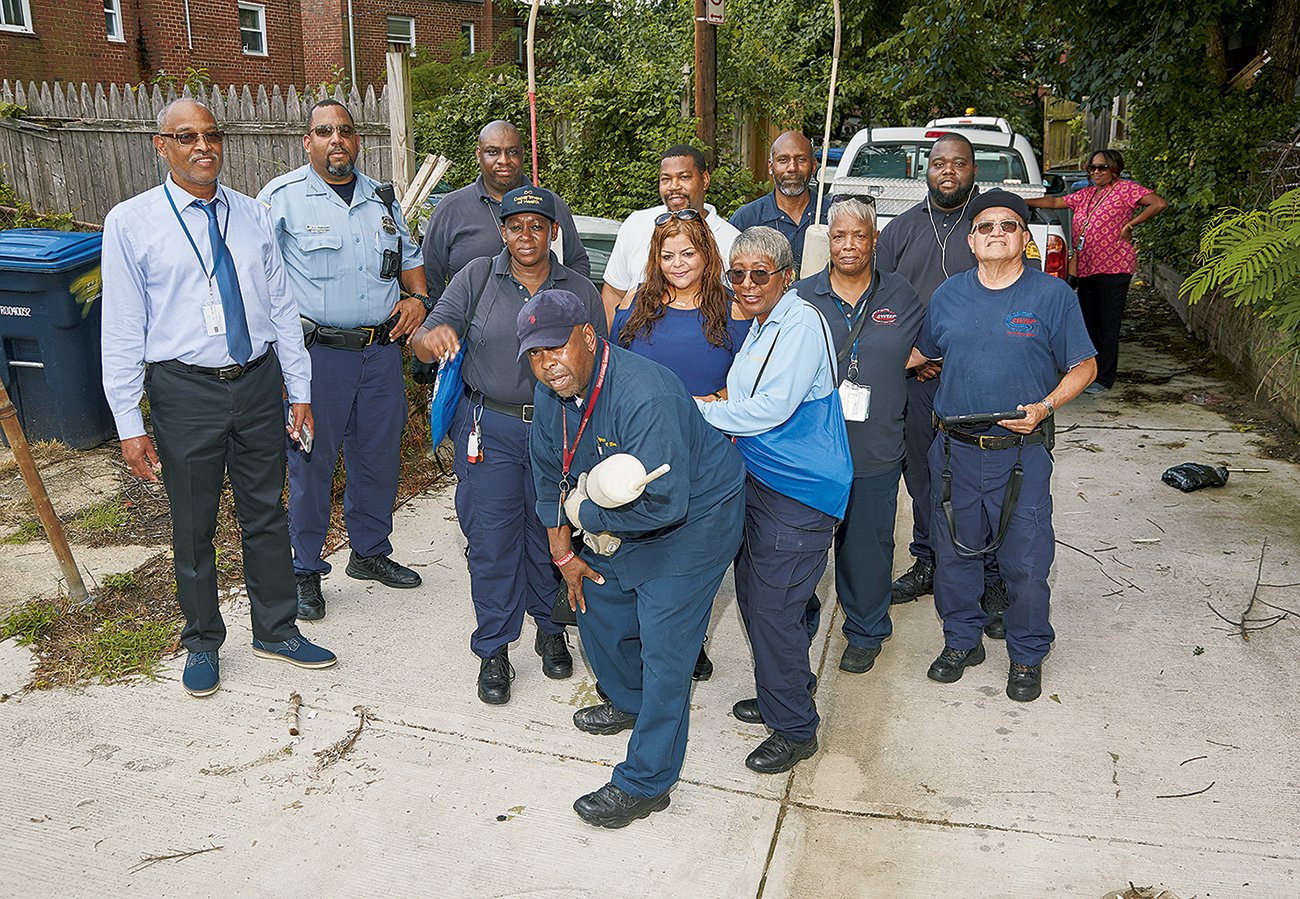
There’s little doubt Washington could do more to combat rats—but at what cost and for how long? In the 1960s, local activist Julius Hobson caught rats, put them in a cage, drove to Georgetown, and threatened to release them in wealthy, white neighborhoods unless the government did more to exterminate rats in the poorer, predominantly African-American areas of the District. A New York City activist emulated his tactics in 1967, bringing a rat in a cage to Congress. Those stunts helped spur $40 million in federal extermination funding, some of which helped pay for the DC-wide “war on rats” of the 1970s. But subsequent budget cuts gutted that program. Perhaps predictably, rat-related complaints to the city between 1995 and 1999 rose by 20 percent. With rodents back in the news, Mayor Anthony Williams that year held a first-of-its-kind “rat summit” of national experts, presaging yet another crackdown. It dissipated, too.
Thus two decades later, here I am, holding Crane’s bag.
I never do bring myself to look inside, although Marina Streznewski later emails me a photo of its (a) very furry and (b) very dead contents. Partly, this is because I’m well and truly grossed out. Partly, it’s because I don’t need to see the casualties. By now, I know the real enemy isn’t at the grates.
Photo-illustrations by Eddie Guy.
This article appears in the September 2018 issue of Washingtonian.
